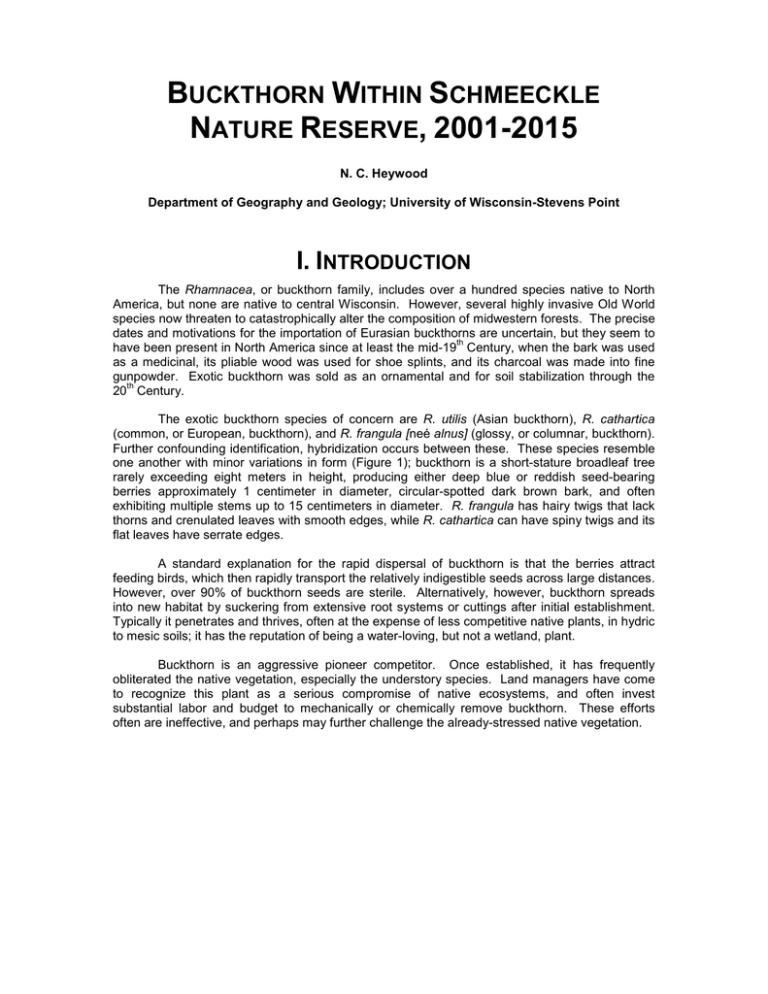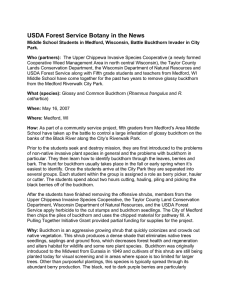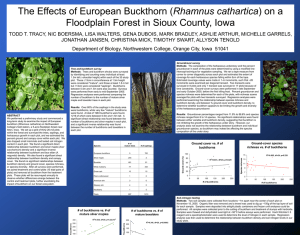B W S N
advertisement

BUCKTHORN WITHIN SCHMEECKLE NATURE RESERVE, 2001-2015 N. C. Heywood Department of Geography and Geology; University of Wisconsin-Stevens Point I. INTRODUCTION The Rhamnacea, or buckthorn family, includes over a hundred species native to North America, but none are native to central Wisconsin. However, several highly invasive Old World species now threaten to catastrophically alter the composition of midwestern forests. The precise dates and motivations for the importation of Eurasian buckthorns are uncertain, but they seem to th have been present in North America since at least the mid-19 Century, when the bark was used as a medicinal, its pliable wood was used for shoe splints, and its charcoal was made into fine gunpowder. Exotic buckthorn was sold as an ornamental and for soil stabilization through the th 20 Century. The exotic buckthorn species of concern are R. utilis (Asian buckthorn), R. cathartica (common, or European, buckthorn), and R. frangula [neé alnus] (glossy, or columnar, buckthorn). Further confounding identification, hybridization occurs between these. These species resemble one another with minor variations in form (Figure 1); buckthorn is a short-stature broadleaf tree rarely exceeding eight meters in height, producing either deep blue or reddish seed-bearing berries approximately 1 centimeter in diameter, circular-spotted dark brown bark, and often exhibiting multiple stems up to 15 centimeters in diameter. R. frangula has hairy twigs that lack thorns and crenulated leaves with smooth edges, while R. cathartica can have spiny twigs and its flat leaves have serrate edges. A standard explanation for the rapid dispersal of buckthorn is that the berries attract feeding birds, which then rapidly transport the relatively indigestible seeds across large distances. However, over 90% of buckthorn seeds are sterile. Alternatively, however, buckthorn spreads into new habitat by suckering from extensive root systems or cuttings after initial establishment. Typically it penetrates and thrives, often at the expense of less competitive native plants, in hydric to mesic soils; it has the reputation of being a water-loving, but not a wetland, plant. Buckthorn is an aggressive pioneer competitor. Once established, it has frequently obliterated the native vegetation, especially the understory species. Land managers have come to recognize this plant as a serious compromise of native ecosystems, and often invest substantial labor and budget to mechanically or chemically remove buckthorn. These efforts often are ineffective, and perhaps may further challenge the already-stressed native vegetation. Page 2 of 6 10/16/15 Figure 1. Glossy buckthorn (Rhamnus frangula). At left: leaves have alternating ribs, tending to be duller and somewhat hairy on the underside. Above: multiple stems from a common rootstock may form linear or circular clusters, and allow for vigorous vegetative reproduction. A. Schmeeckle Nature Reserve; Stevens Point, Wisconsin Schmeeckle Nature Reserve came to exist in 1977 as a result of land donations and purchases, and cooperative planning between local businesses, governments, and the University of Wisconsin-Stevens Point. Including more recent additions, the reserve currently consists of some 275 acres of mixed forests, wetlands, and grassy oldfields (Figure 2). It is the site of the Wisconsin Conservation Hall of Fame, with a museum, conservation laboratories, and classrooms. The reserve provides multiple-use benefits to the surrounding community, with emphasis on preservation, restoration, education, recreation, and flood control. Figure 2. Schmeeckle Reserve Observation Sites, 2001-2015 10/16/15 Page 3 of 6 Invasive buckthorn seems to have substantially increased as an understory presence in Schmeeckle Reserve over the past two decades, so much so that for the past fifteen years considerable investment of cost and labor has been devoted to attempting its removal or containment. These efforts often have been frustrated, as buckthorn vigorously resprouts to dominate the understory almost as fast as land managers can remove it (Figure 3). Glossy buckthorn (R. frangula) is the most common variety in Schmeeckle. Figure 3. Buckthorn Understory Re-establishment Site F, immediately following mechanical clearing of aboveground buckthorn stems by a crew of nine persons, laboring for three days. Site F, two years to the hour after mechanical clearing. Many regrowth stems are over two meters tall. Overstory was ~40 year jack pine. 1) Long-term Monitoring Despite growing concern, no mapping of buckthorn distribution and spread within Schmeeckle Reserve seems to have occurred before September 2001. Since then, successive classes of Geography 358 therefore have obtained buckthorn measurements and observations Page 4 of 6 10/16/15 within the Reserve, enabling creation of maps portraying its distribution and spread. Specifically, these undergraduates at permanent measurement sites have: • mapped the density and dominance variations of buckthorn • mapped the tree ring age variations of cut buckthorn stems • noted associations of habitat factors with buckthorn presence (or absence) Students have regularly obtained measurements and observations at twenty-six locations (Sites A through Z, in Figure 2 above) within Schmeeckle since 2001. 1) Field Findings, 2001-2015 Students have monitored the mean percentage of all woody stems that were buckthorn as a measure of dominance, and the mean count of buckthorn stems per square meter (of buckthorn-occupied quadrats only) as density. Half of the sites had buckthorn exceeding 50% of all woody plants in 2001, and both density and dominance have since generally increased at most sites, despite control efforts (Figure 4). Mary Williams, assistant to former Chancellor Lee Sherman Dreyfus, recalled in her memoirs that even in 1976 some buckthorn existed within the area that was then being proposed for a future nature preserve, along the highway borrow pit that would eventually become Lake Joanis. In the years since 2001 students have also sampled and mapped buckthorn ages by tree ring counts; sure enough, the largest and oldest buckthorn consistently occurs along the north shore of the lake, and dates back to 1977. Did waterfowl attracted to the new water body carry in buckthorn seeds? Was the original borrow pit used as a disposal site for ornamental buckthorn clippings? Was buckthorn deliberately planted to stabilize the new lakeshore? Or did it spread into the new disturbance from previously-established stands? The answers remain unknown. Certain habitat associations have been regularly observed with either high presence or relative absence of buckthorn within the Reserve. Buckthorn existed at most observation sites, but had especially GREATER presence in mesic soils at transition edges between early and later successional communities. In these situations sunlight was abundant, ground vegetation and leaf litter density/depth was low, and competition from native species was relatively minimal. Areas that had recently experienced mechanical clearing for buckthorn control subsequently exhibited very rapid re-infestation, implying that not only can buckthorn quickly re-establish itself to dominance following mechanical clearing, but may even “prefer” such disturbed locations over those remaining in existing state without control efforts. Buckthorn was quite notably LESS a presence in three habitat situations: standing surface water, heavily shaded locations with deep leaf litter, and places where aggressive native competitors (e.g., raspberry, sweetfern, and dogwood) were well-established. Somewhat surprisingly, aspen, cherry, and jack pine do not appear to compete well against buckthorn. Figure 4. Site F: Buckthorn Overgrowing Removal Notification Sign, 2001 10/16/15 Page 5 of 6 1) Dispersal Buckthorn seems to be spreading further within Schmeeckle Reserve. At the observation sites predicted by the 2001 students to be likely for greater future buckthorn infestation, nearly all subsequently have exhibited more buckthorn (Figure 5). The only exceptions were a site that has been more frequently inundated during recent years due to drainage management changes, and the area of the Moses Creek Restoration Project that began in 2010. Otherwise, it is spreading. Figure 5. Projections and Observations of Buckthorn >75% Dominance, 2001-2015 a. where predicted 2001 b. where observed 2001 c. where observed 2011 C. Significance If buckthorn continues to invade Schmeeckle, it seems possible that it will displace less competitive native understory plants, and may prevent regeneration of aging overstory natives. The even-aged jack pine (Pinus banksiana) stand at Site F may be in particular peril because the existing trees are nearing the end of their life expectancy, virtually no seedlings exist, buckthorn now has high density and comprises >80% of all woody plants, and the area has experienced recent disturbance stresses during buckthorn removal operations. Teaberry and princess pine were abundant in this stand just 25 years ago; both are almost entirely gone now. Should such radical composition transformations occur, the effects are likely to extend to displacement of many native animal species dependent upon native stands, and unable to utilize buckthorn as habitat. Lower stature and less continuous canopy also may result in increases of Page 6 of 6 10/16/15 runoff (and erosion), or earlier and accelerated snowmelt (and flooding). Further, such changes probably would not confine themselves to the reserve, but likely would affect the human community and campus surrounding the Reserve. Additionally, an infested Reserve might become the locus of dispersal for buckthorn itself into the periphery, especially if rapid transport of viable seed by birds proves to be a regular phenomenon. It seems likely that some of the general public is either insufficiently aware, or perhaps completely unaware, of the magnitude and rapidity of Schmeeckle Reserve’s buckthorn invasion. Aside from possible mis-identification or a mistaken belief that buckthorn is native here, this plant’s dense green foliage may create a false impression of good ecosystem health. Along with direct control efforts, we believe that an education campaign relating environmental and potential cost information to the public needs to become a necessary part of management practice. To conclude, the 2015 status is that exotic buckthorn is now more widespread, and it now dominates the woody plant composition within much of the Schmeeckle Nature Reserve. This Eurasian plant is a versatile and aggressive invader, is infesting and impacting ever more of the diverse array of native plant understory communities, and continues to exhibit very rapid regeneration in areas where mechanical clearing has recently occurred. Earnest and innovative control efforts have proven stopgap containment at best, and unless public support can enable more effective buckthorn control, much of Schmeeckle may become transformed into an exotic green wasteland within just another generation. The future for the native vegetation within Schmeeckle Reserve currently appears grim. Do we care?







